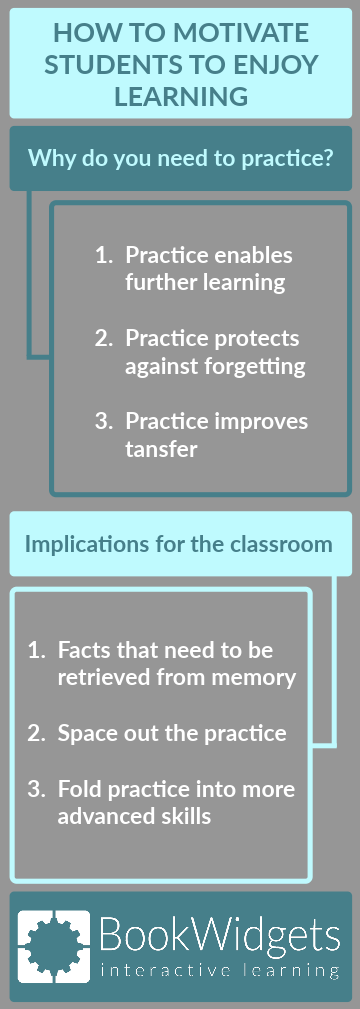How to Motivate Students to Enjoy Learning - Part 4
 Lucie Renard —
Lucie Renard —
I have been busy the past few months, but I didn’t forget about the series. So here I am with a new post. This blog post series will answer one of the most important questions in education history: how to motivate students to enjoy learning?
Reading the book “Why don’t students like school” by Daniel T. Willingham inspired me to write a short series of blog posts on this topic. I highly recommend to read this book! (This is the fourth post in the series, here’s a link to part 1, part 2 and part 3.)
In order to encourage your students to learn, we have to understand their brain and their thinking. How do they think? What do they think about? How does the student’s peculiar brain work?
In this post, my focus is on this important question: “Is drilling worth it?”
Drill and kill
When you think about a drill exercise, you think about the army. It brings up negative feelings and you know you are going to sweat. The term drill implies something unpleasant that is performed in the name of discipline rather than for the student’s profit.
“Drill and kill” isn’t brought to life for no reason. Teachers drill the students and that kills the students’ motivation to learn. But actually, we don’t mean for students to drop out when we want them to drill learning materials. We just want them to practice.
And that’s why I already have to answer the question “Is drilling worth it?”. If you refer to drilling as practicing you know the answer yourself. Yes, practice is necessary. It is kind of impossible to become proficient at a mental task without any extended practice.
You have to learn certain facts by heart in order to become a pro. Think about a chef. He can’t create new recipes if he doesn’t know the basic skills of cooking and which flavors can match other flavors. That are things the chef has to practice.

So if you can’t go around practicing, you need some tips. What lesson material is important enough to practice over and over again? And how can you implement practice in a way that students find it useful and interesting? I’ll answer that in the classroom implications.
Why practice?
First this: why do we practice? To begin with, we practice to master a certain skill. Take for instance a child tying her shoelaces without any supervision of her parents. That takes practice. We also practice to develop skills. I’m pretty good at writing blog posts. But I keep practicing writing to become even better, to write without any spelling mistakes and to really find a way to capture my readers.
In education it’s the same. Students practice to master a certain process. For other skills, such as reading and writing, students must practice to refine and improve their abilities.
Gaining competence and improving are two reasons to practice and there are some other reasons as well, but they aren’t obvious improvements in our abilities. Here they are:
1. Practice enables further learning
Practice leads to automatization. Automatization leads to space in your working memory. Space in your working memory leads to further learning.
Let me explain this process to you. Take for example, tying a shoelace again. When you were little you needed to think with every step in the process of tying your shoelace. Your working memory was stuffed with the process of only one goal: “How the hell am I going to tie my shoelaces?”. You probably said the different steps out loud while tying those shoelaces. “Over, under, around and through, Meet Mr. Bunny Rabbit, pull and through.”
And how is that now? Still saying that rhyme out loud or in your head? I don’t think so. Over the years, you’ve been practicing over and over again tying your shoelaces. It has become an automatized process, that doesn’t require thinking anymore. You can easily start a conversation with someone while tying your shoelaces. Your working memory isn’t really working on those shoelaces anymore. It has made place for other thinking processes, like having a conversation. It has made place for further learning.

2. Practice protects against forgetting
I studied economics in high school. After that, I studied communication in college and after that, I got my teachers degree. Just like any other human being, I’ve been studying a long time. Even now I’m still learning and practicing.
If you ask me something about economics, or mathematics, you name it. I’m sure I won’t remember, even if I passed the subject easily. So, why is that? It’s very simple. Practice.
If you ask me about social media, public relations, blogging, SEO, education, teaching and learning techniques, make sure to make some time. I probably won’t let you go until I finished my story. So what’s so different between economics and math, and all the other subjects I just summed up? Yup, practice.
I only remembered the things I need to know because I use them daily. Social media is part of my daily routine, just as keeping up with education. I can say that I’m practicing those subjects day in, day out. This means that practice protects against forgetting.
It doesn’t matter if you got an A, a B or a C on that one test. Without practicing, you are forgetting the learning material as fast as a student with C, even if you got an A. That’s frustrating isn’t it? Not to mention that when a student with a C kept on practicing, he will know more than you at the end. Of course, this all seems more than logical.
3. Practice improves transfer
It’s hard for students to transfer learning to other situations. When they have learned a special process to solve that question, they often forget that they can use the same process for another solution.
So what can possibly help you with getting students to say: “Oh, I’ve seen problems like this before and I remember how to solve them.”?
There are a few factors that contribute to a successful transfer, but let’s focus on practice for now. Working out lots of problems of a particular type makes it easier to recognize the underlying structure of the problem, even if you haven’t seen that particular version of the problem before.
Practice makes it more likely to understand a problem in the first place and that you’ll remember it later on. If you don’t understand and remember the principle, you can’t transfer it to a new situation.
This is why it’s hard for young children to transfer learning to new situations. They haven’t encountered that many problems yet. And if they have, sometimes, they just don’t understand the problem.

Implications for the classroom
One thing should be clear now: practice is good. The downside of practice is pretty obvious: It’s kind of boring to practice something if you’re not getting any better at it. Here are some classroom tips for teachers:
1. Facts that need to be retrieved from memory
There’s no time to practice everything extensively. And you’re in luck. Not everything needs to be practiced. Ask yourself the question: “Which processes need to become automatic?”. Because, as you know now: “Automatization leads to space in your working memory. Space in your working memory leads to further learning.”
Students need to be able to retrieve facts automatically from different classes. This means that those facts are different for every teacher.
When you teach history, you want your students to retrieve important historical dates , a science teacher wants his students to retrieve the most important elements of the periodic table and a computer science teacher wants its students to be able to type blindly in order to keep their heads clear for other computer exercises.
Learning to speak and read fluently is probably the most important process that needs to be automatized.
In general: the building blocks of skills that will provide the most benefit if automatized. Those building blocks are the things you do again and again in a subject area and that are required for more advanced work.
2. Space out the practice
You don’t have to do all of the practice within a short amount of time or even within a particular unit. Try to space out the practice.
Memory is more enduring when practice is spaced out. No need for cramming. And you know, practicing the same skill over and over again can become a little (read enormously) boring.
If material from a week or a month, or even a longer period ago is included in the practice, students must think more carefully about how to tackle the problem.
3. Fold practice into more advanced skills
It’s possible you want to focus on practicing a basic skill to the point of mastery, but that doesn’t mean that students can’t practice more advanced skills too. The smart way is to distribute practice not only across time, but also across activities. There are so many different and creative ways to practice really crucial skills. Don’t forget that students can still get practice in the basic skills while they are working on more advanced skills. Two birds, one stone.
Wrap up
So that’s it for part 4. I hope you learned that drilling - or better - practice, IS worth it. If you wish to continue to part 5, please click here.
Stay updated on education-related blog topics by following us on Twitter and becoming a member of our Facebook community. Together, we’re working towards improving education!💪
By the way, don’t hesitate to connect with me on LinkedIn 😉



